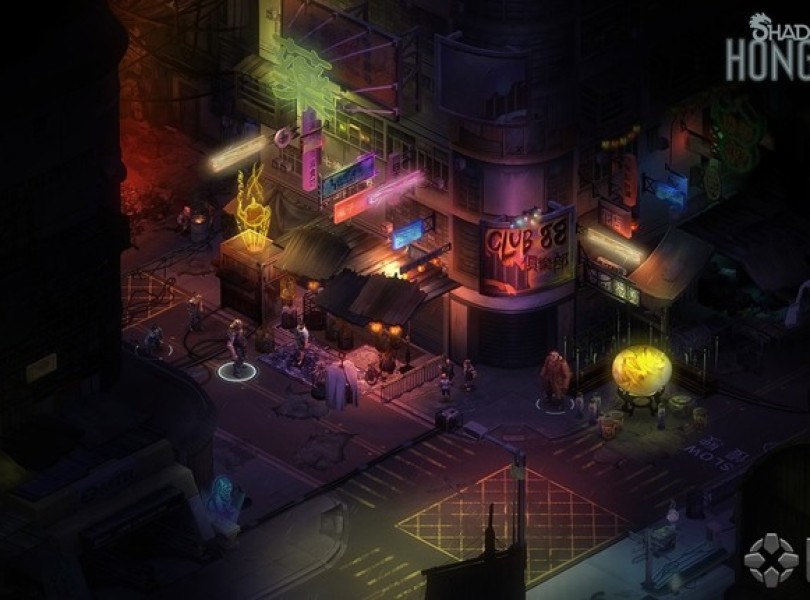Ork Shui.
By Leif Johnson
Good soundtracks aren’t always good indicators of good games, but it’s happily the case with Shadowrun: Hong Kong. The artistry of composer Jon Everist’s work reveals itself in the opening titles, and maintains an atmosphere of subdued mystery through character creation and beyond – spilling over into the first conversations and battles effortlessly and memorably. It hints at the other enjoyable things that wait ahead, and though its story struggles to maintain focus at times, Shadowrun: Hong Kong is another great adaptation of the well-loved tabletop universe.
That beautiful score pairs well with the visuals, which are full of thoughtfully placed shadows and lovingly crafted shops and seedy docks. They’re more detailed than what we saw in Harebrained Schemes’ previous Shadowrun: Dragonfall, partly because the PC exclusivity of Hong Kong kept Harebrained from having to keep things simple for eventual mobile ports.
The action unfolds in the same Blade Runner-meets-Lord of the Rings milieu that characterizes Shadowrun, where orks, elves, and other fantasy mainstays trot around with the guns, leather couture, and slatted glasses the cyberpunk setting demands. It’s a fun concept, but one that’s not quite powerful enough on its own to sustain itself through this, Harebrained’s third outing with the series. Shifting the setting to Hong Kong in 2056 helps immensely, as it allows the series to both recall ’80s cyberpunk masterpieces like Neuromancer and to escape its own increasingly predictable and bare-bones dystopian trappings.


Advertisement
Advertisement
This is a world where people eke out their lives on barges and where the ramshackle dangers of Kowloon Walled City still exist, and it allows Shadowrun: Hong Kong to feel different without major changes to the gameplay. In a series rife with magic, the setting lets Shadowrun to embrace Asian forms of mysticism, right down to quests where you’re expected to mess with a company’s feng shui and cause its workers to perform poorly. It runs the danger of becoming a tad too silly for its own good, yes, but Harebrained take special care to balance these moments with alternatives such as genuinely haunting scenes of slum folk driven near to insanity by mysterious nightmares.
Shadowrun: Hong Kong manages to feel different without major changes to the gameplay.
All of this makes for a memorable (if text-heavy) story and — in spirit, at least — the combination of the attractive setting and quality writing leads me to like it more than what I saw in either vanilla Shadowrun Returns or last year’s Dragonfall. Even in the briefest interactions, the writing involved reads like something you’d get from a studio 10 times Harebrained’s size. Elsewhere, its central premise of a fairly ordinary troll (in my case, at least) who gets caught up in the underworld after getting framed makes a little more sense in the context of learning new skills than the previous games’ insinuation that you’d been “shadowrunning” for years.
The setup leaves a good impression that lasts for hours, but alas, it erodes ever so slightly as the roughly 15 hours of gameplay march by. For one, Shadowrun: Hong Kong runs the danger of falling into yet another “chosen one” story while also sharing a bit too many thematic similarities with Dragonfall; for another, its large, sprawling isometric environments strive too eagerly for the semblance of an open world. It loses some of its focus in the process. In fact, aside from the strong focus on the main storyline at the beginning and ending, much of my time seemed devoted to side-quests and roaming, which seems a little sad after the tightly crafted stories from Harebrained’s previous efforts.
Granted, the writing excels even in the side quests, but much of Hong Kong’s core story nevertheless lacks a certain spark. The comparative deficiencies reveal themselves most in the companions, whose predictable characterizations generally lack the appeal of Dragonfall’s Eiger or Glory despite the pages of pages of text and dialogue options that went into crafting their backstories. The one exception is a red samurai ghoul named Gaichu, and it’s possible we wouldn’t even have had him had the Kickstarter campaign not reached its particular stretch goal funding.
I can’t say I was ever exactly bored, though, and I suspect I have Shadowrun: Hong Kong’s many little improvements to thank for that. They’re everywhere, and a quick trip I took into Harebrained’s original Shadowrun from 2013 felt frustrating and unfulfilling after getting used to them. The interface has improved, and it’s now easier to perform tasks such as switching out items among party members. Decking — Shadowrun’s hip term for hooking up to the Matrix — has dramatically improved, as it’s now possible to get through the relevant stages without fighting on account of some light stealth elements. Before, you had to fight it out. With Hong Kong, there’s some tension to certain would-be encounters, which marks a vast improvement over the comparative tediousness of previous versions of the Matrix.
The core XCOM-style tactical combat is also harder this time around, and I love it. (Some striking exceptions exist, though, including an underwhelming final boss fight.) Being rather cavalier about my positioning, I almost got one of my three starting characters killed in the first combat encounter on the normal mode, and as for the hard mode? It rightfully lives up to its name. That’s never a problem, though, as the turn-based tactical combat itself has never worked so well as it does here.
The catch is that almost nothing has changed about it aside from the aforementioned ability to stealth past some encounters, but the improvements to character abilities like magic and decking are generally enough to quell desires for new features. Other options help, too, such as the ability to start the tactical combat before enemies see you in order to coordinate surprise attacks. The one area where newcomers might run into a bit of trouble is in Shadowrun: Hong Kong’s obvious assumption that you’re already familiar with this type of gameplay and Shadowrun’s own stat and leveling conventions, but to Harebrained’s great credit, it’s not too difficult to pick up.
Shadowrun: Hong Kong doesn’t change much about the core gameplay experience that developer Harebrained Schemes has given us for three years now, but it makes up for it with a quality tactical RPG that’s challenging, well-written, and filled with memorable visuals and audio. What it lacks in new features it makes up for in improving old ones, such as a better experiences in the Matrix as well as improved interface options.





